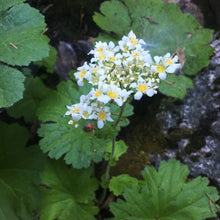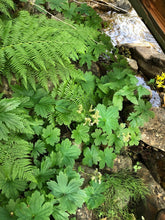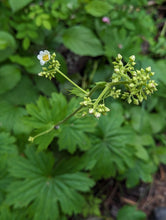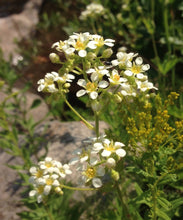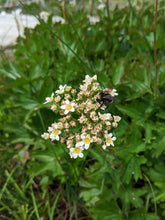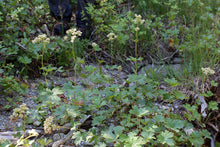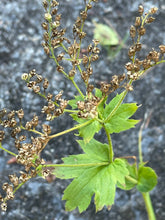
Boykinia major
Mountain boykinia, also known as mountain brookfoam or large boykinia, will be one of the most cheerful in your shady woodland garden. It boasts dense clusters of white-petaled flowers with bright yellow centers that have an impressively long bloom time, appearing in early summer and happily sticking around until fall. Its uniquely saw-toothed leaves are exceptionally broad, reaching up to eight inches wide, and provide a luscious groundcover if planted in multiples.
- Plant type/canopy layer: deciduous, perennial, herbaceous plant
- Size at maturity: 6-48" tall, 12-24" wide
- Light requirements: part sun/part shade, full shade
- Moisture requirements: moist soil
- Bloom time: July - September
- Growth rate/ease: fast growing, easy to grow
- Wildlife support: flowers attract and provide nectar to butterflies, bees and other insect pollinators; overall plants attracts and supports beneficial and other pest eating insects
- Native habitat/range: locally common in meadows and moist riverbanks throughout most of western Oregon and northwestern California. Portland Plant List - no.
- Special features & uses: pollinator favorite; groundcover; landscape uses include shady raingardens, woodland gardens and pollinator gardens
Gardening with Mountain Boykinia: This adorable plant will thrive in most-to-fully shady areas with consistently moist soil - such as those with lots of organic material, leaf litter and companion plants that can help keep it moist in summer. Or be prepared to give it occasional water during our seasonal drought. To create a groundcover effect that is most beneficial to pollinators, be sure to plant many individual plants in continuous drifts.
Photo Credit 1 (flowers, leaves): © Matt Berger, some rights reserved (CC-BY)
Photo Credit 2 (streamside with ferns): © Will McFarland, some rights reserved (CC-BY)
Photo Credit 3 (buds): © My-Lan Le, some rights reserved (CC-BY)
Photo Credit 4 (flowers): © Adam J. Searcy, some rights reserved (CC-BY)
Photo Credits 5 & 7 (with bee, mountain view): © Kayla Sweeten, some rights reserved (CC-BY)
Photo Credit 6 (wild population): © Steve Matson, some rights reserved (CC-BY)
Photo Credit 8 (seed heads): © Stephen, some rights reserved (CC-BY)








